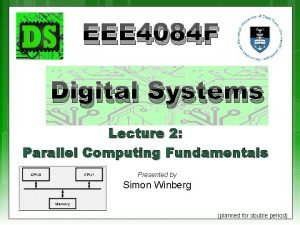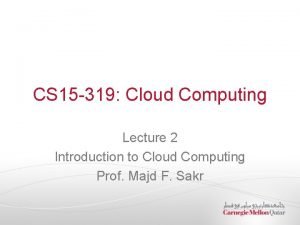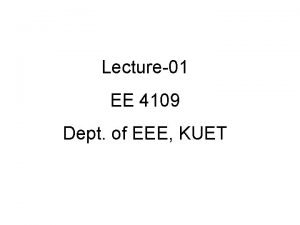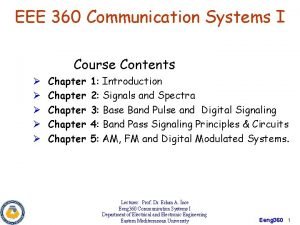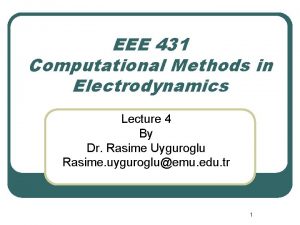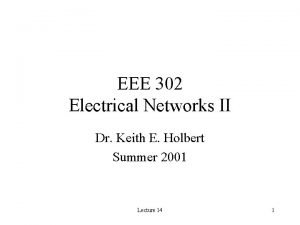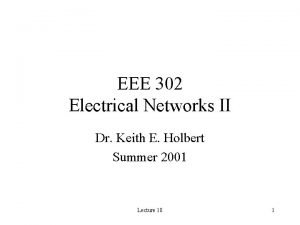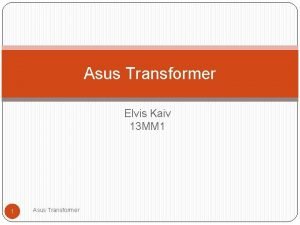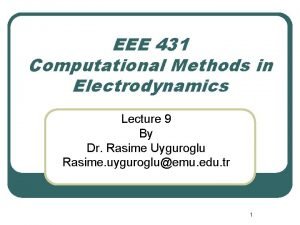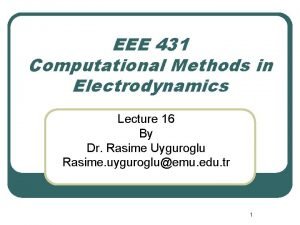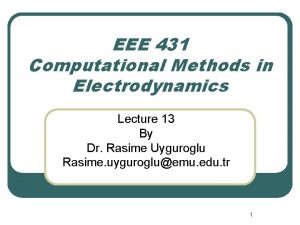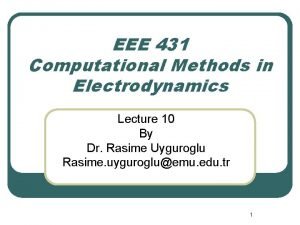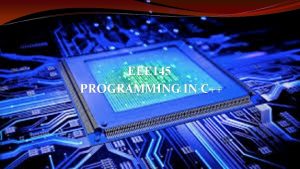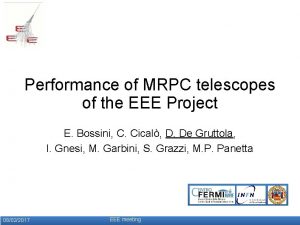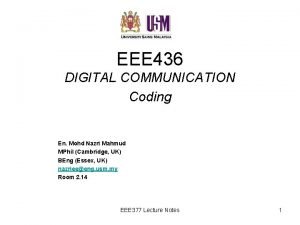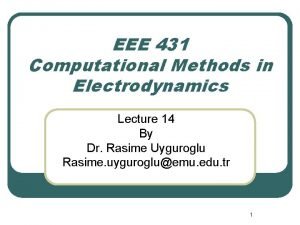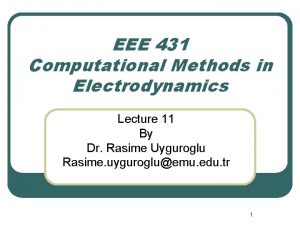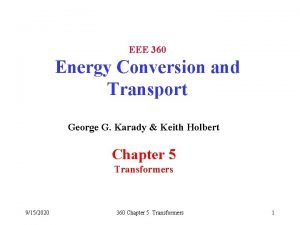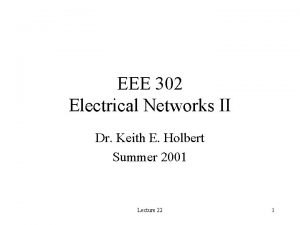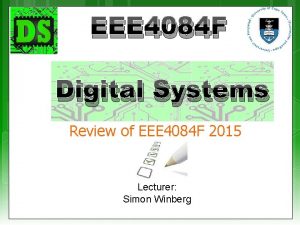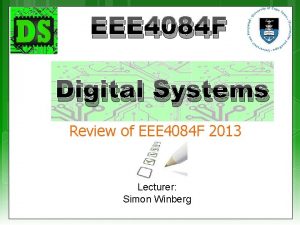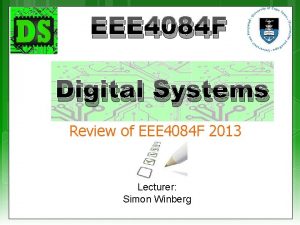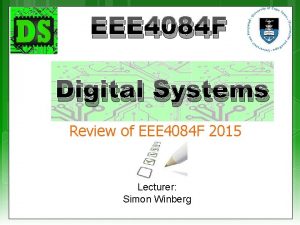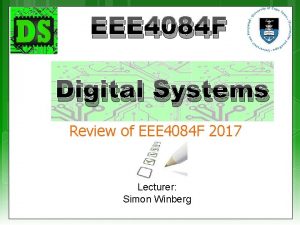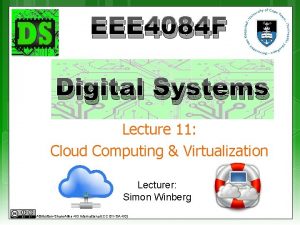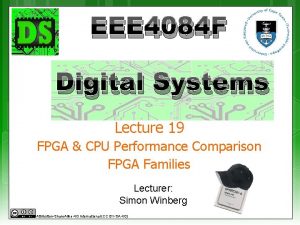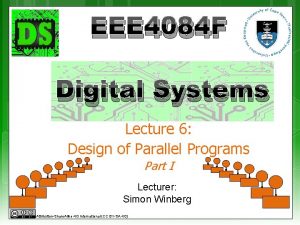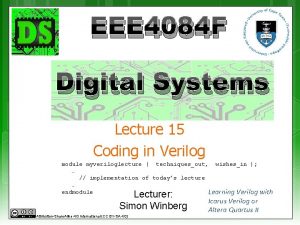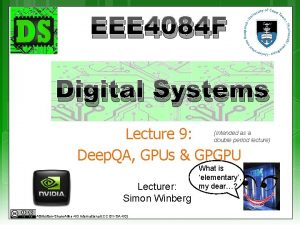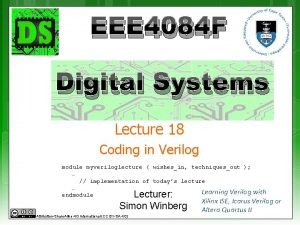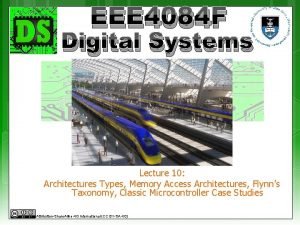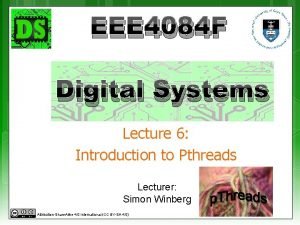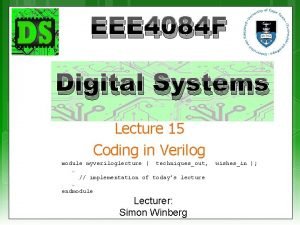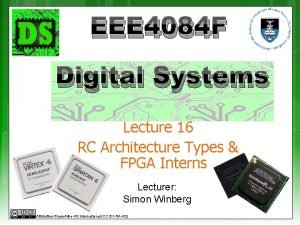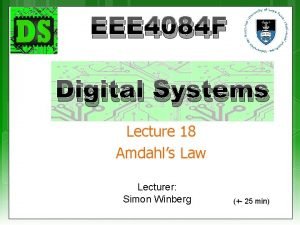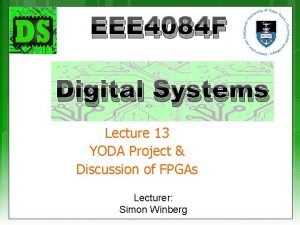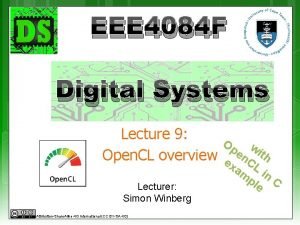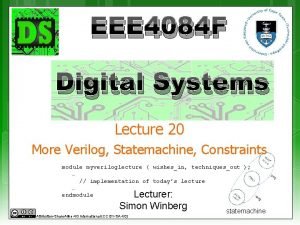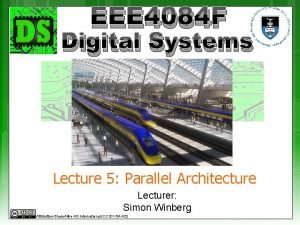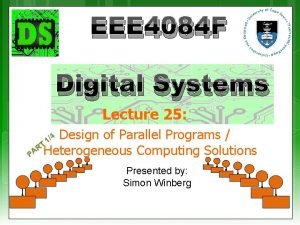EEE 4084 F Digital Systems Lecture 11 Cloud






















- Slides: 22

EEE 4084 F Digital Systems Lecture 11: Cloud Computing & Virtualization Lecturer: Simon Winberg Attribution-Share. Alike 4. 0 International (CC BY-SA 4. 0)

Lecture Overview Cloud computing Virtualization

Cloud Computing EEE 4084 F

Cloud Computing Cloud computing is a style of computing in which dynamically scalable and usually virtualized computing resources are provided as a service over the internet. Cloud computing use: Request resources or services over the internet (or intranet) Provides scalability and reliability of a data center The following video presents this technology and its benefits…

Cloud Computing: a short but informative marketing clip… Salesforce. com - What is Cloud Computing (4 min) Watch on your own : Cloud Computing- What is Cloud Computing. mp 4 (less sales talk) https: //www. youtube. com/watch? v=u. YGQcm. ZUTaw

Checking your understanding… Which one(s) of these are not official Cloud Computing Services as mentioned in the video? … answer … 1. Daas Infrastructure as a Service 2. Iaa. S Platform as a Service 3. Paa. S Software as a Service 4. Saa. S 5. Yaa. S ? ?

Characteristics On demand scalability Add or subtract processors, memory, network bandwidth to your cluster (Be billed for the Qo. S / resource usage) Virtualization Request and virtual systems & services operating system, storage, databases, other services

Key Technology for Cloud Computing: Virtualization App App App OS OS OS Operating System Hypervisor Hardware Traditional Computing Stack Virtualized Computing Stack Discussed a bit later…

Cloud Computing Models Driving philosophy: Why buy the equipment, do the configuration and maintenance and yourself, if you can contract it out? Can work out much more cost effectively. Utility computing (kind of Iaa. S) Rent cycles Examples: Amazon’s EC 2, Go. Grid, App. Nexus Platform as a Service (Paa. S) Provides user-friendly API to aid implementation Example: Google App Engine Software as a Service (Saa. S) Just run it for me (and make sure it keeps running) Example: Gmail Infrastructure as a Service (Iaa. S) Just give me remote access to some machines, I’ll take care of installing and running programs on them and sort out software issues on my own.

Amazon Web Services Elastic Compute Cloud (EC 2) Rent computing resources by the hour Basic unit of accounting = instance-hour Additional cost for bandwidth usage Simple Storage Service (S 3) Persistent storage Charge by the GB/month Additional costs for bandwidth (Planning a guest lecture / seminar by Engineer(s) from Amazon Data Center for both ECE & CS Hons class to happen soon)

Virtualization EEE 4084 F

What is virtualization? The concept of “cloud computing” is often used as a generalized term to refer to remotely accessing application software stored on centralized servers or a cluster where you don’t know which PC may be hosting the app. The term “virtualization” is sometimes confused with “cloud computing”, typically used incorrectly in such situations (to refer to a virtual computer). While these technologies are similar the terms are not interchangeable…

Definitions Definition Cloud of Cloud Computing: computing is a computing term or metaphor that evolved in the late 2000 s, based on utility and consumption of computing resources. Cloud computing involves deploying groups of remote servers and software networks that allow centralized data storage and online access to computer services or resources. [source: www. en. wikipedia. org/wiki/Cloud_computing ]

Definitions Definition of Virtualization: Virtualization (in computing) refers to the act of creating a virtual (rather than actual) version of something, including but not limited to a virtual computer hardware platform, operating system (OS), storage device, or computer network resources. [Source: www. en. wikipedia. org/wiki/Virtualization] It is essentially software that separates physical computing infrastructures to create a variety of dedicated computing resources. It is the fundamental technology behind cloud computing, particularly as it allows a consistent software layer for the same programs to run on different hardware. (see next slide for elaboration…)

Virtualization software allows multiple operating systems and multiple applications all to run at the same time on the same server. “It enables businesses to reduce IT costs while increasing the efficiency, utilization and flexibility of their existing computer hardware. ” -- Quote by Mike Adams (VMware director of product marketing)

Difference between virtualization and cloud computing Main fundamental difference between these: Virtualization is software that manipulates hardware and provides a layer to present a consistent interface; whereas cloud computing is a service / collection of services that runs on top of that layer (i. e. , on the virtual machine). You can also argue that: Cloud computing is the delivery of services, using shared computing resources, software or data, ondemand through via Internet. Whereas virtualization is more a lower level interface unseen by the users. A confusion is “virtualization as a service” – i. e. where the cloud basically provides virtual machines and operating system of the particular type requested that the users then writes code for. (tends to be a type of Iaa. S)

You don’t have to have a cloud for the virtualized environment A major advantage of app app virtualization is allowing for app Cloud Services sustainability (increased Virtualized product lifespan) of crucial Environment software products, such as bespoke applications developed Crucial Software in-house and which are very Product important for the business. (e. g. expert system, estimation Virtualized engine, simulation modelling) Environment

Example Virtualization Products EEE 4084 F

Common Virtualization Products Name Creator Host CPU Guest CPU Host OS Guest OS License bhyve Free. BSD x 86 -64 Free. BSD, Open. BSD, GNU/Linux … BSD x 86, ARM Linux, Windows, Mac OS X, Be. OS, Free. BSD, Solaris, QNX, IRIX, Amiga. OSymbian, … Internally emulated DOS shell; classic PC booter games, … GPL x 86 -64, (up to 64 physical CPUs) Windows 8/8. 1 & Windows Server 2012 (R 2) w/Hyper-V role, Microsoft Hyper. V Server supported drivers for Windows NT, Free. BSD, Linux (SUSE 10, RHEL 6, Cent. OS 6) … Proprietary x 86, x 86 -64 Windows, Linux, Mac OS X x 86, Solaris, Free. BSD, e. Com. Station DOS, Linux, Mac OS X Server, Free. BSD, Haiku, OS/2, Solaris, Syllable, Windows. , GPL version 2; full version with extra enterprise features is proprietary: Peter Veenstra, Sjoerd, community help Any Hyper-V (2012) Microsoft x 86 -64 + hardware-assisted virtualization (Intel VT-x or AMD-V … Virtual. Box Innotek, acquired by Oracle Corporation x 86, x 86 -64, Intel VT-x, AMD-V Windows Virtual PC Connectix & Microsoft x 86, x 86 -64 with Intel VT-x or AMDV x 86 Windows 7 Windows XP, Windows Vista, Windows 7, … VMware Server VMware x 86, x 86 -64 Windows, Linux Same as VMware ESX Server DOSBox Proprietary (generally free for non-comm. ) Proprietary Adapted from: http: //en. wikipedia. org/wiki/Comparison_of_platform_virtualization_software

Should you consider virtualization? Virtualization using a virtual computer could be an effective way to reduce risks in project development and to save setup time. For example if working on a team project one person could be responsible for configuring the computer (getting all the tool setting right etc. ) and then share the computer with the rest of the team. Similarly if the physical PC is damaged the virtual computer could simply be used on an alternate PC without having to go through the process of setting up the OS, tools, libraries etc.

Next lecture Next Lecture System Later MPI Management Lecture and Open. MP

Disclaimers and copyright/licensing details I have tried to follow the correct practices concerning copyright and licensing of material, particularly image sources that have been used in this presentation. I have put much effort into trying to make this material open access so that it can be of benefit to others in their teaching and learning practice. Any mistakes or omissions with regards to these issues I will correct when notified. To the best of my understanding the material in these slides can be shared according to the Creative Commons “Attribution-Share. Alike 4. 0 International (CC BY-SA 4. 0)” license, and that is why I selected that license to apply to this presentation (it’s not because I particulate want my slides referenced but more to acknowledge the sources and generosity of others who have provided free material such as the images I have used). Image sources: Wikipedia (open commons) www. flickr. com (public domain images) Picture of running going up stairs – Wikimedia open commons http: //pixabay. com open commons / public domain images
